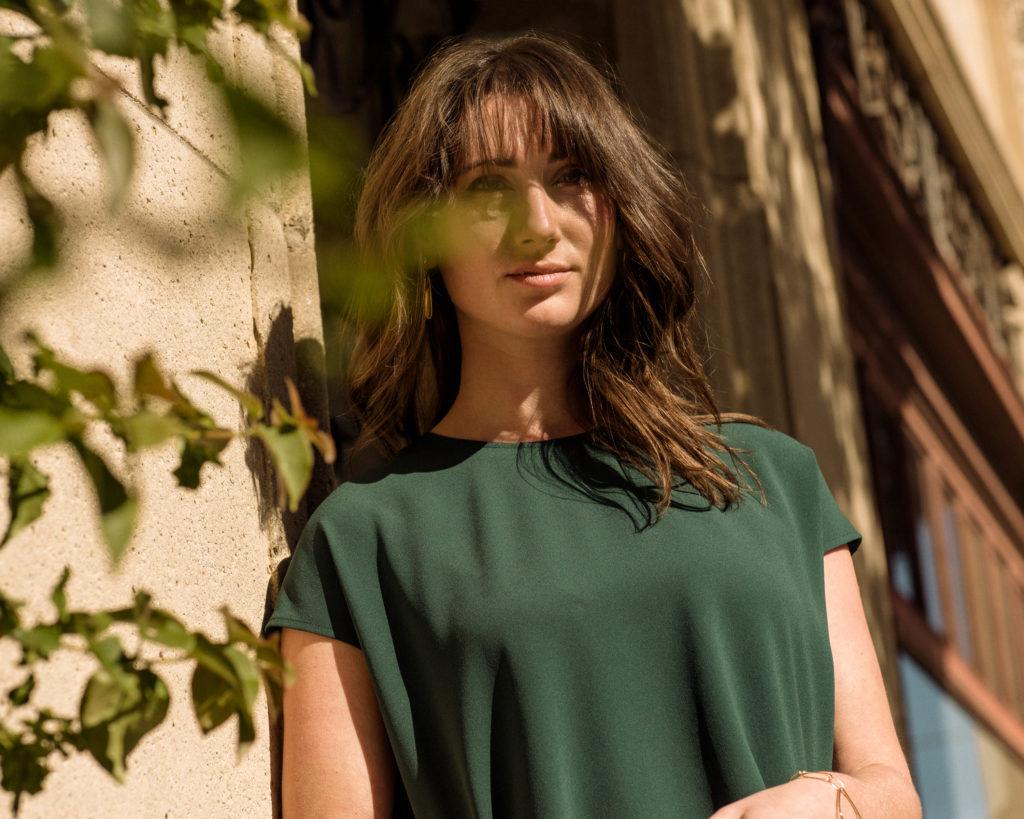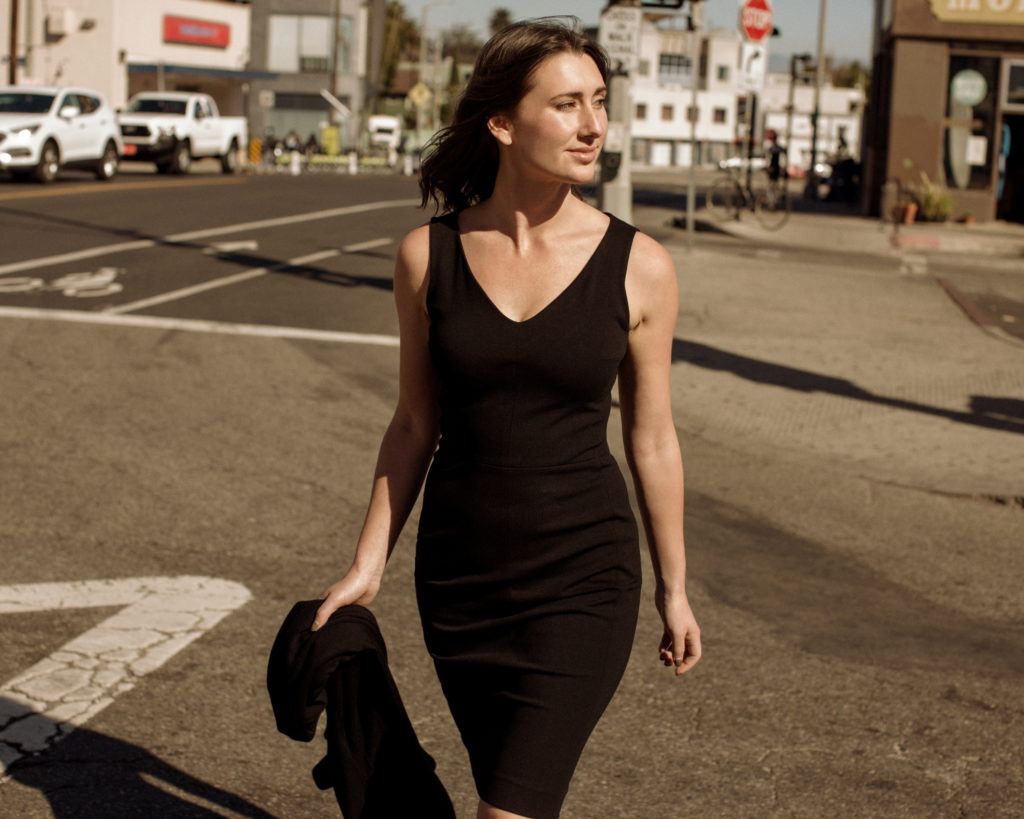Ad Producer Annie Dietz on Finding Creative Balance
April 26, 2018 | Filed in: Woman of the Week
The set of a large-scale advertising production can be chaotic: There might be dozens of people, equipment everywhere, props, loud music, tables of food to prevent “hanger.” Keeping everyone on task (and on time) is no easy feat, and that’s where Annie Dietz comes in. As a producer for a Los Angeles-based creative agency, she oversees the creation of commercial video campaigns. Here, she talks about balancing creativity with budgets, how to say no without shutting people down, and finding her career sweet spot.
I WORK ON PRODUCTIONS FOR commercials as a producer, and it’s my responsibility to bring together budget and creative to make the work happen. My role is to be the hub of the production wheel, and all the other departments are the spokes. My background is more creative than most agency producers, and as a result, I’m sort of a hybrid. Usually, a producer is the budget and logistics person. But I went to grad school for documentary filmmaking, and in that field, the producer is also the person who researches the topic, has the creative vision, and runs the interviews—you don’t have the budget to hire separate people to do those things.

Annie wears the Arbus sweater in wolfling and the Oshima pant in black.
AFTER GRAD SCHOOL, I got a job as a documentary producer. We had tiny budgets, and I’d work closely with a creative director. We would set up the interviews, I would go out and shoot everything, and then we’d figure out the story together. I took that creative aspect for granted a little bit, and assumed that’s what all producers did.
MY BOSS AT MY FOLLOWING JOB at a traditional ad agency encouraged me to be creative and even to direct, because he recognized that I had different skills from other producers, but it was an uphill battle trying to convince other creatives at the agency that his producer, especially a female producer, could also direct. I was able to do it occasionally, but still, I felt pigeonholed in my role there.

Annie wears the Didion top in viridian, the Telesto earrings, and the Galatea bracelet.
I JOINED THE AGENCY WORLD specifically because I wanted to learn how to work with bigger budgets—how to scale, essentially. Before, if someone had given me a million dollars for a production, I would have no idea what to do with it. I felt like I needed to understand what a “real” set looked like, and the range of people that would be there, and the strategy behind how they would all fit together. Now that I have sharpened that particular skill set, I want to return to the creative side of things—though, as I’ve progressed, I’ve seen that some of my strengths do lie in management. It’s a weird balance between what I would prefer to be doing versus where my skills will be the most valuable.
AT MY CURRENT JOB, I was hired because of my hybrid background. A lot of advertising production has become really clunky, with huge budgets and big, crowded sets, and that makes it difficult to create fast, high-quality advertising content that is also affordable. It’s like that triad everyone talks about—good, fast, cheap—where you can only ever have two out of three. Clients want more content for less money, because people consume everything so quickly on the internet, so agencies need people who can think outside the box. Television is dying, and the agency model is dying along with it, so I think everyone’s scrambling to figure out what the next best thing is.

Annie wears the Rachel dress in black.
WHEN IT COMES TO PROBLEM-SOLVING AND MANAGING PEOPLE, I think it’s important to make people feel good about their ideas. If you say “no” right off the bat, which is sometimes tempting to do, it can appear combative—maybe not if you’re a man, but definitely if you’re a woman. “No” can make it feel like you’re not a willing partner. In disagreeing with someone else’s creative vision, I always try to come across as representing the best interest of the work and its outcome. I try not to argue so much as remind people what the overall mission is, and whether their idea will serve it. Sometimes you do have to be stern, but that’s because not everyone understands the nuances of where the creative vision and the dollars meet.
I DON’T THINK MUCH ABOUT WHAT I WEAR in terms of how I come across professionally. I just dress the way I like to dress. The more I feel like myself, the more comfortable I am, and the more my clothes are not a distraction to me. Whether it means I’m wearing a crop top underneath overalls, or I’m wearing a more formal shift dress, I just open my closet and think, “What will make me feel good today?” That enables me to come into work and do the best job I can.

Annie wears the Arbus sweater in wolfling and the Oshima pant in black.
I ALMOST EXCLUSIVELY WEAR HEELS. I also wear jeans a lot, although I do wear dresses, too—I like to shake things up. I’m not afraid of form-fitting pieces that show my body. Being a woman isn’t something that should be detrimental to my career. Growing up in New York definitely influenced my personal style. It’s like seeing a fashion show, just walking around. At the beginning of my career, when I didn’t have a lot of disposable income, I shopped wisely. I bought a couple of investment pieces that I still have, like a navy blue dress that I got for job interviews when I was a senior in college. It was $90 on sale, which seemed like so much at the time, but it’s silk-lined and really well made, and I still wear it and it still looks great. For trendy clothes, I’ll buy cheap stuff, but for classics, I’ll invest.
I MOVED TO LOS ANGELES IN JULY 2017. I will be a New Yorker forever, no matter what, but I’m settling into a routine here. I think it’s important to push yourself to try new surroundings. I think it makes you a more well-rounded person, and keeps you curious. Also, this job was intriguing to me—specifically this marriage of journalism and advertising that they were asking me to do. It’s a unique blend of the things I had been training myself for all along.
Speaking of moving to Los Angeles—we’re popping up on the west coast from May 17-23. Come visit! Book an appointment here.
Photographs by Clarke Tolton.





